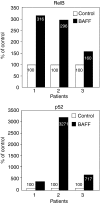Role of BAFF and APRIL in human B-cell chronic lymphocytic leukaemia
- PMID: 16827889
- PMCID: PMC1782305
- DOI: 10.1111/j.1365-2567.2006.02377.x
Role of BAFF and APRIL in human B-cell chronic lymphocytic leukaemia
Abstract
B-cell chronic lymphocytic leukaemia (B-CLL) is the most prevalent leukaemia in Western countries and is characterized by the gradual accumulation in patients of small mature B cells. Since the vast majority of tumoral cells are quiescent, the accumulation mostly results from deficient apoptosis rather than from acute proliferation. Although the phenomenon is relevant in vivo, B-CLL cells die rapidly in vitro as a consequence of apoptosis, suggesting a lack of essential growth factors in the culture medium. Indeed, the rate of B-CLL cell death in vitro is modulated by different cytokines, some favouring the apoptotic process, others counteracting it. Two related members of the tumour necrosis factor family, BAFF (B-cell activating factor of the TNF family) and APRIL (a proliferation-inducing ligand), already known for their crucial role in normal B-cell survival, differentiation and apoptosis, were recently shown to be expressed by B-CLL cells. These molecules are able to protect the leukaemic cells against spontaneous and drug-induced apoptosis via autocrine and/or paracrine pathways. This review will focus on the role of BAFF and APRIL in the survival of tumoral cells. It will discuss the expression of these molecules by B-CLL cells, their regulation, transduction pathways and their effects on leukaemic cells. The design of reagents able to counteract the effects of these molecules seems to be a new promising therapeutic approach for B-CLL and is already currently developed in the treatment of autoimmune diseases.
Figures




Similar articles
-
BAFF and APRIL expression in B-cell chronic lymphocytic leukemia: correlation with biological and clinical features.Leuk Res. 2009 Oct;33(10):1319-27. doi: 10.1016/j.leukres.2009.03.030. Epub 2009 Apr 23. Leuk Res. 2009. PMID: 19395025
-
The BAFF/APRIL system: life beyond B lymphocytes.Mol Immunol. 2005 May;42(7):763-72. doi: 10.1016/j.molimm.2004.06.041. Epub 2004 Dec 8. Mol Immunol. 2005. PMID: 15829264 Review.
-
The role of the BAFF/APRIL system in B cell homeostasis and lymphoid cancers.Curr Opin Pharmacol. 2004 Aug;4(4):347-54. doi: 10.1016/j.coph.2004.02.009. Curr Opin Pharmacol. 2004. PMID: 15251127 Review.
-
B cell activation through CD40 and IL4R ligation modulates the response of chronic lymphocytic leukaemia cells to BAFF and APRIL.Br J Haematol. 2014 Feb;164(4):570-8. doi: 10.1111/bjh.12645. Epub 2013 Nov 18. Br J Haematol. 2014. PMID: 24245956
-
Novel function of TNF cytokines in regulating bone marrow B cell survival.Cell Mol Immunol. 2004 Dec;1(6):447-53. Cell Mol Immunol. 2004. PMID: 16293214
Cited by
-
Rapamycin inhibits B-cell activating factor (BAFF)-stimulated cell proliferation and survival by suppressing Ca2+-CaMKII-dependent PTEN/Akt-Erk1/2 signaling pathway in normal and neoplastic B-lymphoid cells.Cell Calcium. 2020 May;87:102171. doi: 10.1016/j.ceca.2020.102171. Epub 2020 Feb 7. Cell Calcium. 2020. PMID: 32062191 Free PMC article.
-
The noncanonical NFκB pathway: Regulatory mechanisms in health and disease.WIREs Mech Dis. 2024 Nov-Dec;16(6):e1646. doi: 10.1002/wsbm.1646. Epub 2024 Apr 18. WIREs Mech Dis. 2024. PMID: 38634218 Review.
-
Rapamycin inhibits BAFF-stimulated cell proliferation and survival by suppressing mTOR-mediated PP2A-Erk1/2 signaling pathway in normal and neoplastic B-lymphoid cells.Cell Mol Life Sci. 2015 Dec;72(24):4867-84. doi: 10.1007/s00018-015-1976-1. Epub 2015 Jun 29. Cell Mol Life Sci. 2015. PMID: 26118661 Free PMC article.
-
NF-κB-p62-NRF2 survival signaling is associated with high ROR1 expression in chronic lymphocytic leukemia.Cell Death Differ. 2020 Jul;27(7):2206-2216. doi: 10.1038/s41418-020-0496-1. Epub 2020 Jan 28. Cell Death Differ. 2020. PMID: 31992855 Free PMC article.
-
Comparative expression profile of orphan receptor tyrosine kinase ROR1 in Iranian patients with lymphoid and myeloid leukemias.Avicenna J Med Biotechnol. 2011 Jul;3(3):119-25. Avicenna J Med Biotechnol. 2011. PMID: 23408747 Free PMC article.
References
-
- Keating MJ. Chronic lymphocytic leukemia. Semin Oncol. 1999;26:107–14. - PubMed
-
- Kay NE, Hamblin TJ, Jelinek DF, Dewald GW, Byrd JC, Farag S, Lucas M, Lin T. Chronic lymphocytic leukemia. Hematology (Am Soc Hematol Educ Program) 2002:193–213. - PubMed
-
- Byrd JC, Stilgenbauer S, Flinn IW. Chronic lymphocytic leukemia. Hematology (Am Soc Hematol Educ Program) 2004:163–83. - PubMed
-
- Decker T, Hipp S, Ringshausen I, Bogner C, Oelsner M, Schneller F, Peschel C. Rapamycin-induced G1 arrest in cycling B-CLL cells is associated with reduced expression of cyclin D3, cyclin E, cyclin A, and survivin. Blood. 2003;101:278–85. - PubMed
-
- Caligaris-Cappio F. Biology of chronic lymphocytic leukemia. Rev Clin Exp Hematol. 2000;4:5–21. - PubMed
Publication types
MeSH terms
Substances
LinkOut - more resources
Full Text Sources
Other Literature Sources
Miscellaneous

